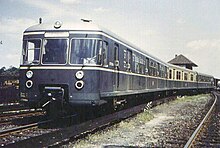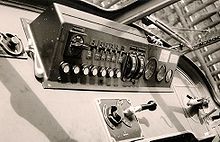DB series ET 170
| DB series ET / EM 170 DB series 470/870 |
|
|---|---|
|
Class 470 train at Altona station
|
|
| Numbering: | ET 170 101-145a, EM 170 101-145, ET 170 101-145b 470 101-145, 870 101-145, 470 401-445 |
| Number: | 90 railcars 45 intermediate cars |
| Manufacturer: | MAN , O&K , Rathgeber , Wegmann , SSW , BBC |
| Year of construction (s): | 1959 1967-1970 |
| Retirement: | until 2002 |
| Axis formula : | Bo'Bo '+ 2'2' + Bo'Bo ' |
| Genre : | B4tr + A4 + B4tr |
| Gauge : | 1435 mm ( standard gauge ) |
| Length over coupling: | 65.520 mm |
| Width: | 2,900 mm |
| Trunnion Distance: | 14,480 mm (ET) 13,060 mm (EM) |
| Bogie axle base: | 2,600 mm |
| Service mass: | 111 t |
| Wheel set mass : | 12.0 t |
| Top speed: | 100 km / h |
| Hourly output : | 8 × 160 kW = 1,280 kW |
| Acceleration: | 1.0 m / s² |
| Driving wheel diameter: | 950 mm |
| Impeller diameter: | 950 mm |
| Motor type: | DC series connection |
| Power system : | 1200 V DC |
| Power transmission: | Side pantograph Third rail |
| Number of traction motors: | 8th |
| Coupling type: | Scharfenberg coupling |
| Seats: | 68 / 1–130 / 2 |
| Classes : | 1st / 2nd |
The ET 170 series (from 1968 the 470 series ) was a multiple unit of the Deutsche Bundesbahn and was in service with the Hamburg S-Bahn until 2002 . It was based in the Hamburg-Ohlsdorf depot.
history
These multiple units were developed from the ET 171 series in the 1950s . In 1959 they were presented to the public and initially delivered to the German Federal Railroad with 16 multiple units . Another eight multiple units followed in a second series in 1967, and the last 21 vehicles of this type were delivered from 1968 to 1970 . The companies MAN , O&K , Rathgeber , Wegmann , SSW and BBC were involved in the construction of a total of 45 multiple units .
construction
The multiple unit is a three-part set and consists of two end rail cars and a non-powered intermediate car. The road numbers were 470 101–470 145 or 470 401–470 445 for the end rail cars and 870 101–870 145 for the intermediate cars.
A welded lightweight construction was chosen for the car bodies , in which the floor pan is designed as a load-bearing part.
The driver's cab windows at the front of the train are curved on both sides to allow the driver a better all-round view . The end cars have automatic Scharfenberg couplings at the front . There is a close coupling between the carriages of a set , which can only be released in the workshop . There is no passage for travelers between the cars . Each car has four double sliding doors on both sides that close electropneumatically. There is a single sliding door on the left at the head of the two end cars.
The bogies were made by the manufacturer Wegmann with a torsion-free H-frame . Coil springs and dampers ensure the controlled cushioning of the wheel sets and the vehicle frame on the bogie.
The color scheme of the 470 series was originally dark blue with cream-colored decorative lines on the roof edge and below the windows, the center car had a cream-colored ribbon of windows. From the 1980s onwards there were also ocean blue / beige multiple units on the road, with the window strip being in ocean blue and the lower car sides in beige, in contrast to the DB scheme. The railcars were recently also often used as an advertising medium .
The traction current is picked up by four pantographs on each side of the wagon, which can normally be switched on or off using a compressed air drive and, in the event of malfunctions, also manually with the help of an isolated pantograph key.
In each of the two end cars there are four direct-current series motors in tatzlager design. The intermediate cars are not driven, but are used to accommodate electrical units (for example the resistors for the electrical brake) in their floor pan.
In the delivery state, this series also offered the option of feeding energy back into the grid when braking . If the network did not take up the energy, the resistance brake was automatically switched over. Because of the high-maintenance and high-maintenance electrical brake control at the time, regenerative braking was discarded from the mid-1970s.
The railcar has a disc brake , Sifa , train radio and multiple controls. The latter enables the combination with the series 471 , 470 and 472 during operation .
The carriages have a large interior with open, vis-a-vis compartments. The middle cars are 1st class and the end cars are 2nd class. Load compartments with folding seats can be found behind the driver's cabs . All cars had separate smoking and non-smoking compartments until the smoking permit was abolished in the 1970s. The smoking compartments in the second class railcars were located between the cargo and non-smoking compartments, with the cargo and smoking compartments being separated from each other by a wall with a central sliding door. In the cars of the first delivery (1959), a continuous wall with a row of five seats separated the smoking and non-smoking compartments of both first and second class in the middle of the car. In the wagons of the second delivery (1967-70), these partition walls had, instead of the middle seat, a passage with a hinged door, which was provided with a window with vertical, matt decorative stripes. In the 1980s, the partition doors were initially removed, and later the entire partition walls were removed, except for a small web on the ceiling, which also bore the car number.
numbering
Each three-part train unit consisted of a railcar with number 470 1xy, an intermediate car 870 1xy and another railcar with number 470 4xy, with xy running in sequence from 01 to 45. This is analogous to the older trains of the 471/871 series , with the difference that the intermediate cars had the hundreds digit 0 (i.e. 871 0xy). The reason why serial numbers were only assigned from 101 onwards for the 470 series was that they wanted to avoid duplication of numbers with the Deutsche Reichsbahn : the trains were designated as ET 170 (before the switch to six-digit computer numbers), and so did the Deutsche Reichsbahn developed trains of the class ET 170 ("Blue Wonder") at about the same time, the serial numbers of which began with 001.
Whereabouts
The 470 and 471 series have been replaced by the 474 series . The last scheduled day of use of the 470 series was December 17, 2002.
Three units have been preserved, multiple unit 470 136 (Expo train), which has been used as a café since it was parked in the Schmilau adventure station. Furthermore, multiple unit 470 129 and end car 470 437 are owned by the "Verein Historische S-Bahn Hamburg e . V. "Multiple unit 470 128 has been a museum train of the" Verein Historische S Bahn Hamburg e. V. “Special trips are carried out with him.
literature
- Horst J. Obermayer: Paperback German railcars. Franckh'sche Verlagshandlung, Stuttgart 1973, ISBN 3-440-04054-2 .



